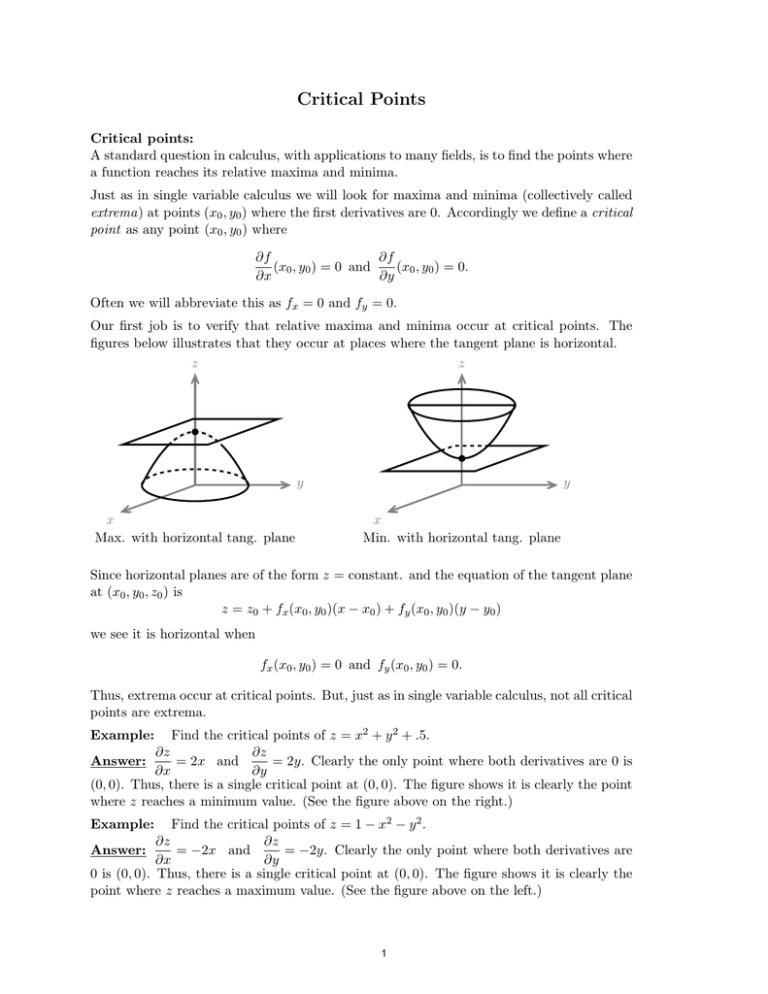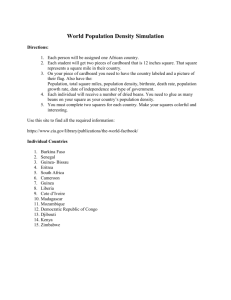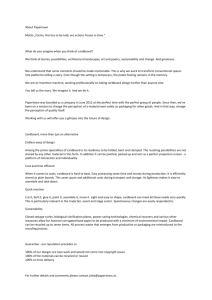Document 13739884
advertisement

Critical Points Critical points: A standard question in calculus, with applications to many fields, is to find the points where a function reaches its relative maxima and minima. Just as in single variable calculus we will look for maxima and minima (collectively called extrema) at points (x0 , y0 ) where the first derivatives are 0. Accordingly we define a critical point as any point (x0 , y0 ) where ∂f ∂f (x0 , y0 ) = 0. (x0 , y0 ) = 0 and ∂y ∂x Often we will abbreviate this as fx = 0 and fy = 0. Our first job is to verify that relative maxima and minima occur at critical points. The figures below illustrates that they occur at places where the tangent plane is horizontal. z z y x Max. with horizontal tang. plane y x Min. with horizontal tang. plane Since horizontal planes are of the form z = constant. and the equation of the tangent plane at (x0 , y0 , z0 ) is z = z0 + fx (x0 , y0 )(x − x0 ) + fy (x0 , y0 )(y − y0 ) we see it is horizontal when fx (x0 , y0 ) = 0 and fy (x0 , y0 ) = 0. Thus, extrema occur at critical points. But, just as in single variable calculus, not all critical points are extrema. Find the critical points of z = x2 + y 2 + .5. ∂z ∂z Answer: = 2x and = 2y. Clearly the only point where both derivatives are 0 is ∂x ∂y (0, 0). Thus, there is a single critical point at (0, 0). The figure shows it is clearly the point where z reaches a minimum value. (See the figure above on the right.) Example: Find the critical points of z = 1 − x2 − y 2 . ∂z ∂z Answer: = −2x and = −2y. Clearly the only point where both derivatives are ∂x ∂y 0 is (0, 0). Thus, there is a single critical point at (0, 0). The figure shows it is clearly the point where z reaches a maximum value. (See the figure above on the left.) Example: 1 Find the critical points of z = −x2 + y 2 . ∂z ∂z Answer: = −2x and = 2y. Clearly the only point where both derivatives are ∂x ∂y 0 is (0, 0). Thus, there is a single critical point at (0, 0). The figure shows it is neither a minimum or a maximum. z Example: y x Saddle with horizontal tang. plane Example: Making a box with minimum material. A box is made of cardboard with double thick sides, a triple thick bottom, single thick front and back and no top. It’s volume = 3. What dimensions use the least amount of cardboard? Answer: The box shown has dimensions x, y, and z. The area of one side = yz. There are two double thick sides ⇒ cardboard used = 4yz. The area of the front (and back) = xz. It is single thick ⇒ cardboard used = 2xz. The area of the bottom = xy. It is triple thick ⇒ cardboard used = 3xy. Thus, the total cardboard used is w = 4yz + 2xz + 3xy. The volume = 3 = xyz ⇒ z = 3 xy . Substituting this in the formula for w gives w= 12 6 + + 3xy. x y We find the critical points of w. 12 6 wx = − 2 + 3y = 0, wy = − 2 + 3x = 0. y x 4 6 The first equation implies y = 2 . Substituting this in the second equation gives − x4 + 3x = 0. 16 x Thus, x = 0 or 2. We reject 0 since then y is undefined. Using x = 2 we find y = 1. Thus, there there is one critical point at (2,1). and at this point we have z = 3/2. This point gives the box with minimum cardboard used because physically we know it must have a minimum somewhere. Later we will learn to check this with the second derivative test. z y x 2 MIT OpenCourseWare http://ocw.mit.edu 18.02SC Multivariable Calculus Fall 2010 For information about citing these materials or our Terms of Use, visit: http://ocw.mit.edu/terms.






